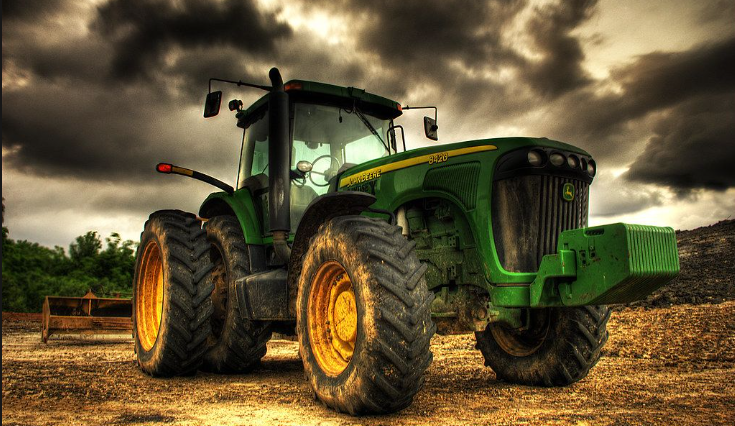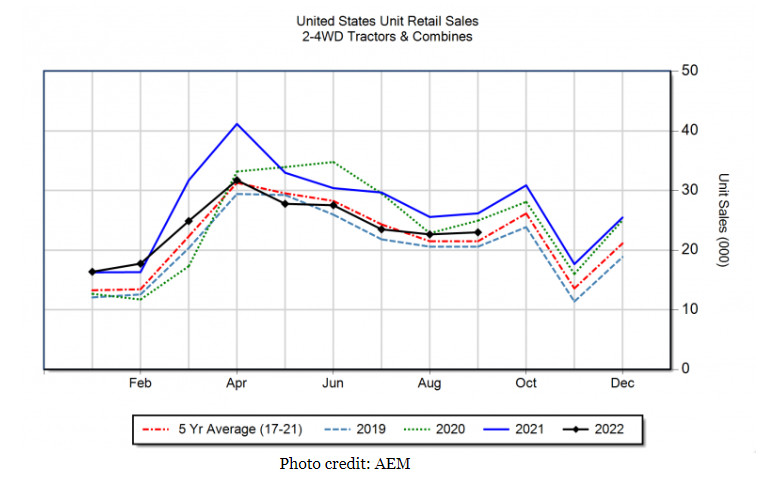“Farm equipment is often difficult to find, and generally higher priced while farmers remain especially hesitant to buy new machinery.”
However, combine sales were up in September compared to August this year, while total tractor sales fell, according to Curt Blades.
Association of Equipment Manufacturers (AME) official, Blades said, “Total U.S. agriculture equipment sales in September were above the five-year average.” But sales were down in nearly all segments from the same time in 2021.
“The ag equipment market, as with most markets for manufactured goods, is turbulent,” Blade evaluated.
Farmers do want to take advantage of efficiency and technology new equipment offers especially with strong commodity markets. “However, supply chain difficulties continue to weigh on manufacturers’ deliveries,” Blade pointed out.
Total farm tractor sales for September 2022 were down 12.8-percent from 2021, but still above sales in August.
At the end of September, the Association of Equipment Manufacturers official said 210,540 total farm tractors had been sold this year. That’s down from 245,807 this time last year.
Sales for two-wheel drive, less than 40-horsepower tractors were down 16.3-percent from 2021. Year to date, 140,790 tractors have been sold in this category, down from 170,715 at the same time last year.
Two-wheel drive, 40 to 100 horsepower tractors sales were down 10.2 percent, from last year. Year to date, 49,468 tractors have been sold in this category, down from 56,445 at the same time last year.
However, sales for two-wheel drive 100 horsepower tractors were up 9.6 percent. 18,146 “big” tractors have been sold, up from 16,257 at the same time last year.
Four-wheel drive tractor sales are down 33.1 percent. A total of 2,136 four-wheel-drive tractors have been sold, down from 2,390 on the same date in 2021.
Sales for self-propelled combines saw growth in September, up a modest 6.6-percent. A total of 4,555 combines have been sold, up from 4,406 by September a year ago.
Shortages of combines, planters, and tractors are well understood by now, Blades pointed out.
But what about grain hauling equipment? “Not as dependent on microchips, perhaps, but it still requires labor and basic raw materials to be constructed,” according to Machinery Insider.
Used-trailer sales tend not to be too seasonal, with the exception of spring planting season when overall auction volume is down.
The number of trailers sold at auction the first quarter of 2022 were only 40 percent of what they were last year and just 25-percent of what was sold at auction in 2020.
“No farmer wants to be stuck not being able to deliver $8 corn.” Machinery Insider officials said. “That incentive plus short supply pushed prices to historic highs.”
Average grain trailer values this year are 25 percent higher than in 2021, and 60 percent higher than in 2020.
Manufacturers are sending new trailers out their doors at record levels. This resupply will eventually help moderate used-trailer values that have been strong this spring and summer.
Used hopper bottom prices have been exceptionally strong the past five to six years even when other farm equipment was depressed. Compared with pre-2021 levels, today’s hopper bottoms average 13-percent to 18-percent higher.
“This higher value, however, trails behind the astronomical prices now given for high-horsepower tractors and combines,” Machinery Insider evaluated.
“Tri-axle trailers are increasingly sought after when hauling grain greater distances or facing long unloading waiting time,” officials said. “The extra 200 to 300 bushels that a tri-axle offers per load is enough to justify the higher cost.”
“New or used, small or large, red or green or blue or purple, machinery supplies are tighter than a drum right now,” Machinery Insider repeated. “But there are exceptions when spending time on the internet searching equipment websites.”
Model year 2019 and 2020 round balers are one of those exceptions. Between 2017 and 2020, cattle prices were stable. Corn, on the other hand, was cheap before a rocket ride late in 2020.
That gave cattlemen nice profits sending them to dealers’ lots to upgrade their hay equipment. “Today balers purchased then are coming into dealers’ lot on trade. This provides an opportunity to find decent prices on late-model round balers.” Machinery Insider reported.
“Well-equipped round balers are selling steady, but not at the level paid for tractors, combines and tillage equipment,” officials evaluated.
These values reflect differences in how well equipped a baler is. For example, specialty crop or silage special machines sell for 15-percent to 30-percent more. Other features add to the price of a machine.
Generally, for farmers looking to upgrade equipment, something off the manufacturer’s line is not possible unless ordered long ago.
“Used quality pieces are out there,” officials reiterated. “Yet, with all that is happening in the ag industry, it’s hard to know how much to pay.”
Estimating sale price has always been difficult, but with supply chain buckling, valuing equipment is harder than ever. “
“Each operation is different. So, purchasing typically comes down to what is needed most and can be afforded for added farm profit,” officials emphasized.
+++30+++

